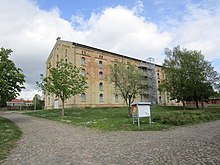Hesterberg (Schleswig)
The Hesterberg ( Danish : Hestebjerg , Low German : Hesterbarg , also Heisterbarg ) is a hill and a district in the city of Schleswig . The Hesterberg extends east of the Gottorfer Neuwerkgarten and northwest of the Lollfußes . Together with the Michaelisberg and the Gallberg, it forms a chain of hills north of the Schlei . The road of the same name leading north divides the hill into Klein- and Groß-Hesterberg.
The Hesterberg was first mentioned in writing in 1448. The name is derived from the Danish word for horse , Hest. At that time the hill was used by the Schleswig city farmers as common pasture land. A local folk tale also explains the name through a successful ruse by Queen Margaret I , who managed to escape from enemies on the hill with the help of her horses. In 1326 there was the battle at Hesterberg , in which the Holstein count Gerhard III. defeated the troops of the Danish King Christoph II . In 1329 Count Gerhard won again over rebellious Jutland peasant troops, who defended themselves against the influence of North German princes in Denmark, which was largely pledged. Two years later, the Danish King Christoph II was finally captured by Count Gerhard III on the Lohheide to the south .
From around 1565, parts of the hill were bought up under Duke Adolf I and an outbuilding was established for the court of the nearby castle. However, this also led to conflicts with the townspeople, who had been using the Hesterberg as a town field to date . In 1662 the first Vorwerk burned down and was rebuilt a little further north. It consisted of several stables and a bakery. There is also said to have been a dairy at times. With the end of the Gottorf ducal house in 1713, the Vorwerk was finally abandoned and partially demolished. From 1745 the land was leased to several users by the Danish king. Around 1755 there was also a faience factory on the Hesterberg for a short time .
From the middle of the 19th century, the Hesterberg was increasingly built on and integrated into the city of Schleswig in terms of urban planning. Finally, the Hesterberger paddocks , which formerly belonged to the municipality of Schuby and the Arensharde, were formally incorporated into the city. Not least with the construction of the Chaussee to Flensburg , the Hesterberg developed into an urban residential area. There were also child and adolescent psychiatry facilities and a larger military magazine, which is now used as the central magazine by the state museums at Gottorf Castle .
literature
- Jürgen Hoppmann: The Schleswig Hesterberg - at the gates of Gottorf. In: Contributions to the history of the city of Schleswig , Volume 42, Schleswig 1997, page 37 ff.
- Ulrich Wilkens: References to Hesterberg, Schleswig. In: Contributions to the history of the city of Schleswig , Volume 43, Schleswig 1998, page 15 ff.
- Joachim Meyerhoff : When will it finally be the way it never was? All dead fly high, part 2. Kiepenheuer and Witsch, Cologne, 13th edition 2016. ISBN 978-3-462-04681-6 . The hero Joachim experienced his childhood as the youngest son of the medical director of the child and adolescent psychiatry Hesterberg.
Web links
Individual evidence
- ↑ Grænseforeningen: Dronning Margretes flies.
- ^ Manfred Jessen-Klingenberg : History of Schleswig-Holstein . An overview by Alexander Scharff (= history of the German states, Territorien-Ploetz: special editions ). 5th, updated and revised edition. Ploetz, Freiburg / Würzburg 1991, ISBN 3-87640-340-5 , p. 31 .
Coordinates: 54 ° 30 ′ 55.4 ″ N , 9 ° 32 ′ 53.5 ″ E

